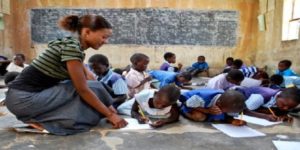 The Ian-Smith regime made education compulsory and universal only for the white child, and in the process spending at least 20 times more on the former than it did on the indigenous black.
The Ian-Smith regime made education compulsory and universal only for the white child, and in the process spending at least 20 times more on the former than it did on the indigenous black.
Subsequently, at independence in 1980, Zimbabwe’s education policy became inclusive, with access to education becoming a basic human right. Having inherited a sound economy, the Zanu PF led government pursued a socialist path, and with that an incredible expansion in schools infrastructure and teacher training programmes.
The Zanu PF government adopted a growth and equality oriented principle in order for the redress the inherited inequalities that had become entrenched not only in education but also in the health sector and other social amenities.
Free Primary Education
The Zanu PF government introduced free primary education that was compulsory for every child in the age group between six and twelve years old. Needless to say, an almost 100% school attendance rate was achieved. By 1990, Zimbabwe had attained universal primary education status, the poor quality in almost a third of its schools notwithstanding, a mere ten years down the line from 1980.
More problems began to sprout when the Zanu PF government adopted and implemented what it called five-year development plans as embodied in Economic Structural Adjustment Programmes (ESAP) in succession from 1991. These structural adjustment programmes resulted in critical underfunding of the education sector.
By then, the demand for education, especially higher education, had plummeted as those who had benefited from free-tuition primary education in the previous decade were now being churned into fee paying secondary schools.
According to World Bank estimates then, expenditure per student in higher education had hit the plus or minus 300% mark in terms of Gross National Product (GNP) per capita, with only 19% of GNP per capita going to primary education. In 2009, UNESCO estimated the literacy rate in Zimbabwe at as high as 91.4%. It is also important to note that the literacy levels of 15-24 year-olds rose from at least 95% to 98% between 1991 and 1998.
Economic and Social Challenges
The above was possible due to the emphasis that government had placed on education after attainment of independence. These gains in education were, however, undermined by the brain drain, including decrease in life expectancy which then stood at 40 years due to the HIV/Aids pandemic and other factors.
In the early 2000s, when the Zanu PF government initiated the chaotic Land Reform Program; economic growth and the standards of education, declined. Thus, the resultant economic meltdown negatively affected the gains that had previously been achieved in the education system.
The controversial Operation Murambatsvina and the resultant evictions rendered many children homeless and unable to attend school. This universal but elusive Free Primary Education was widely perceived as fundamental to national development, not only in Zimbabwe but also in hugely underdeveloped Africa.
Malawi’s rapid implementation of Free Primary Education in 2004 resembled the Zimbabwean model and as a consequence, quality also eluded them as they had to employ unqualified teacher due to a lack of funding. Uganda also fell into the same cesspit whilst Zambia and Kenya addressed a comprehensive teacher development programme before implementation of Free Primary Education.
The political stalemate of 2008 did not help either, as it created more political, economic, and social challenges, and in particular among teachers, which resulted in a very acute shortage of human resources at all levels of the education system.
The Government of National Unity (GNU) that followed a contested election in Zimbabwe appeared only preoccupied with political gamesmanship and as a consequence did not focus on important issues such as Free Primary Education.
Conclusion
In conclusion, Free Primary Education requires massive human and financial resources; above all it thrives on political will and strategic planning. The ongoing political crisis and economic slowdown in Zimbabwe not only makes Free Primary Education impossible to implement but unachievable.
In the end, due to the current political, social and economic crisis engulfing Zimbabwe, the country is caught in a catch 22 position were the government does not have adequate funding for Free Primary Education and the majority of the citizens cannot afford to pay tuition for their children’ education.
Post published in: Education

